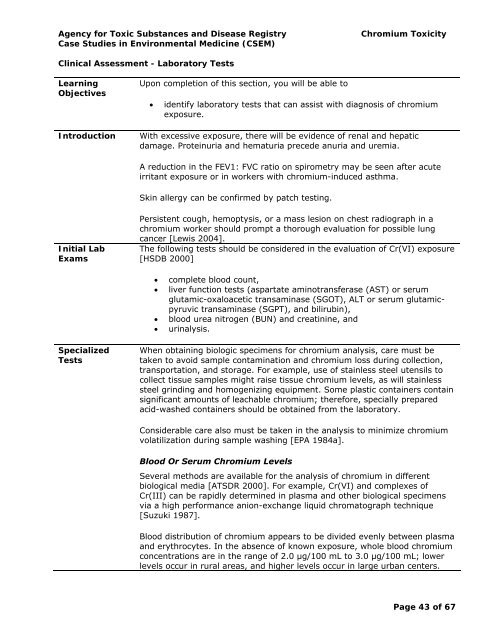(Cr) Toxicity | ATSDR - CSEM - Agency for Toxic Substances and ...
(Cr) Toxicity | ATSDR - CSEM - Agency for Toxic Substances and ...
(Cr) Toxicity | ATSDR - CSEM - Agency for Toxic Substances and ...
Create successful ePaper yourself
Turn your PDF publications into a flip-book with our unique Google optimized e-Paper software.
<strong>Agency</strong> <strong>for</strong> <strong>Toxic</strong> <strong>Substances</strong> <strong>and</strong> Disease Registry Chromium <strong><strong>Toxic</strong>ity</strong><br />
Case Studies in Environmental Medicine (<strong>CSEM</strong>)<br />
Clinical Assessment - Laboratory Tests<br />
Learning<br />
Objectives<br />
Upon completion of this section, you will be able to<br />
• identify laboratory tests that can assist with diagnosis of chromium<br />
exposure.<br />
Introduction With excessive exposure, there will be evidence of renal <strong>and</strong> hepatic<br />
damage. Proteinuria <strong>and</strong> hematuria precede anuria <strong>and</strong> uremia.<br />
Initial Lab<br />
Exams<br />
Specialized<br />
Tests<br />
A reduction in the FEV1: FVC ratio on spirometry may be seen after acute<br />
irritant exposure or in workers with chromium-induced asthma.<br />
Skin allergy can be confirmed by patch testing.<br />
Persistent cough, hemoptysis, or a mass lesion on chest radiograph in a<br />
chromium worker should prompt a thorough evaluation <strong>for</strong> possible lung<br />
cancer [Lewis 2004].<br />
The following tests should be considered in the evaluation of <strong>Cr</strong>(VI) exposure<br />
[HSDB 2000]<br />
• complete blood count,<br />
• liver function tests (aspartate aminotransferase (AST) or serum<br />
glutamic-oxaloacetic transaminase (SGOT), ALT or serum glutamicpyruvic<br />
transaminase (SGPT), <strong>and</strong> bilirubin),<br />
• blood urea nitrogen (BUN) <strong>and</strong> creatinine, <strong>and</strong><br />
• urinalysis.<br />
When obtaining biologic specimens <strong>for</strong> chromium analysis, care must be<br />
taken to avoid sample contamination <strong>and</strong> chromium loss during collection,<br />
transportation, <strong>and</strong> storage. For example, use of stainless steel utensils to<br />
collect tissue samples might raise tissue chromium levels, as will stainless<br />
steel grinding <strong>and</strong> homogenizing equipment. Some plastic containers contain<br />
significant amounts of leachable chromium; there<strong>for</strong>e, specially prepared<br />
acid-washed containers should be obtained from the laboratory.<br />
Considerable care also must be taken in the analysis to minimize chromium<br />
volatilization during sample washing [EPA 1984a].<br />
Blood Or Serum Chromium Levels<br />
Several methods are available <strong>for</strong> the analysis of chromium in different<br />
biological media [<strong>ATSDR</strong> 2000]. For example, <strong>Cr</strong>(VI) <strong>and</strong> complexes of<br />
<strong>Cr</strong>(III) can be rapidly determined in plasma <strong>and</strong> other biological specimens<br />
via a high per<strong>for</strong>mance anion-exchange liquid chromatograph technique<br />
[Suzuki 1987].<br />
Blood distribution of chromium appears to be divided evenly between plasma<br />
<strong>and</strong> erythrocytes. In the absence of known exposure, whole blood chromium<br />
concentrations are in the range of 2.0 μg/100 mL to 3.0 μg/100 mL; lower<br />
levels occur in rural areas, <strong>and</strong> higher levels occur in large urban centers.<br />
Page 43 of 67

















